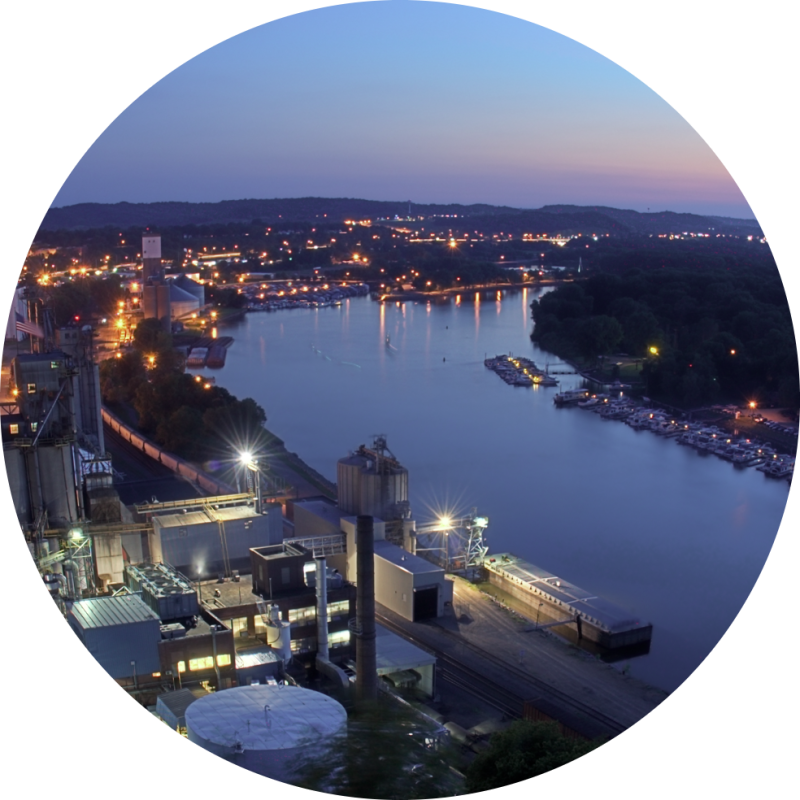Streamlining Minnesota’s environmental permitting process: 2025 update
Overview and key findings
In February 2024, the Minnesota Chamber Foundation released an in-depth report examining the efficiency and transparency of Minnesota’s environmental permitting system. This research – led by Barr Engineering, the Policy Navigation Group, and Squire Patton Boggs – answered key questions about how long it takes to get an air or water permit in Minnesota, how Minnesota’s permitting timelines and processes compare to other states, and what Minnesota can do to streamline its programs in air, water, wetlands and environmental review.
The study found that while Minnesota has areas of strength in its permitting system, businesses often face significantly longer wait times for environmental permits compared to other states. For instance, obtaining a federal individual air permit for construction in Minnesota took 1.5 to six times longer than in states like North Dakota, Iowa, Wisconsin, Illinois, Colorado, North Carolina and Tennessee. The report identified numerous areas for improvement to make Minnesota’s permitting and environmental review programs more streamlined, transparent, certain and collaborative while maintaining Minnesota’s commitment to protecting natural resources and public health.
Minnesota has a long legacy of protecting the natural environment and enabling investments to spur innovation and economic growth. Reforming and modernizing Minnesota’s environmental programs can position the state to build on its existing industry strengths and capitalize on emerging opportunities in energy and clean tech, food and ag innovation, mining, advanced manufacturing and life sciences.
This need is particularly urgent as Minnesota businesses face both new opportunities and growing challenges. Despite the state’s diverse industry strengths, key sectors like manufacturing, mining, construction, and utilities have seen total declines in real GDP in the first half of the decade, ranking in the bottom quarter of all states.
This report looks at permitting activity over the past year to identify areas of progress and continued challenges. The findings reveal mixed outcomes. Minnesota continues to face lengthy review times to issue Tier 2 air and water permits, and there remains a substantial backlog of permit applications that await action and review from agency staff.
However, notable improvements are also evident. For example, while only one priority Tier 2 air permit met the state’s 150-day goal, most were issued in under a year. Further, the typical timeline to issue federal individual air permits improved substantially to an average of 266 days. This may signal that permit applications related to larger capital investment and job creation activities are experiencing faster review times.
This updated research provides high-level context for policymakers, regulators, and other stakeholders seeking to help Minnesota’s regulatory programs and economy perform to their full potential.
Back to top
Tracking progress on efficiency and transparency in Minnesota’s environmental permitting system
Recommendation: Reduce the time it takes to issue priority Tier 2 air and water permits, bringing average and median timeframes closer to the agency’s 150-day goal.
2024 progress
Tier 2 air and water permits issued over the past year continued to face delays though there are some signs of improvement.
Background
The Minnesota Chamber Foundation’s 2024 report showed a stark divide in permit review timelines between Tier 1 and Tier 2 air and water permits. While Tier 1 permits are typically issued within a month of the application being submitted, Tier 2 permits often take a year or longer to be reviewed and issued by the Minnesota Pollution Control Agency (MPCA). This is particularly problematic for “priority” permit applications in which a permit is needed for construction activity to take place at the facility. From 2018-2023, the average duration to issue a priority Tier 2 air permit was 586 days, and the average duration to issue a new priority Tier 2 industrial water permit was 476 days. Some projects take much longer, exceeding 1,000 days to issue, reissue or modify a permit. Reducing permitting timelines for priority Tier 2 air and water permits would make Minnesota more competitive for large economic development investments.
Assessment of 2024 outcomes
All Tier 1 and Tier 2 air permits. The MPCA issued a total of 154 air permits between November 2023 – December 2024, with a total of 64 Tier 1 and 90 Tier 2 permits. Like past research, this review found a large discrepancy between typical timelines between Tier 1 and Tier 2 permits. The median timeline to issue Tier 2 air permits was 596 days, compared to just 28 days for Tier 1 permits. Only three of 90 (3%) Tier 2 permits were issued within the agency’s 150-day goal. Federal reissuances had the longest average timeframes (1,892 days), followed by major amendments (622 days). The fastest approved Tier 2 permits were for moderate amendments (188 days) and new federal individual (266 days).
Priority Tier 2 air permits. The data show mixed results for issuance timelines of priority Tier 2 air permits since November 2023. The median timeframe to issue all priority Tier 2 air permits was 348 days, nearly the same as the median of 350 days in the previous 5-year period. Only one of 35 (3%) priority Tier 2 air permits was issued within the 150-day goal, and eight permits took longer than two years to issue. This demonstrates continued challenges in the timely review of priority Tier 2 air permits.
However, a closer look at the permit data reveals some positive signs as well. While only one permit was issued within 150-days, a plurality (17 of 35) of them were issued between 150 and 365 days of the initial application, meaning that the typical priority permit took more than 150 days but less than a year to issue. Several of the permits that were issued in under a year related to publicly announced business expansion projects, which might indicate faster review times for projects with notable capital investment and job creation activities.
Priority Tier 2 water permits. Priority Tier 2 individual industrial water permits faced similar outcomes, though the MPCA receives far fewer applications of this kind than it does priority Tier 2 air permits. Since fiscal year 2018, the MPCA received just 17 priority Tier 2 water permit applications, and received only two in fiscal year 2024. Those two permit applications received in 2024, along with an additional two applications received in prior years, remained pending as of the end of Q4 2024. The four pending applications have been under review for an average of 829 days.

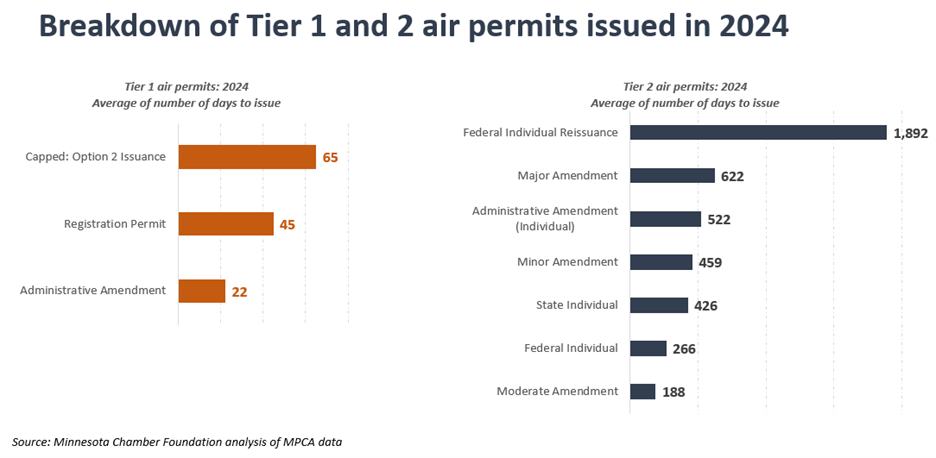
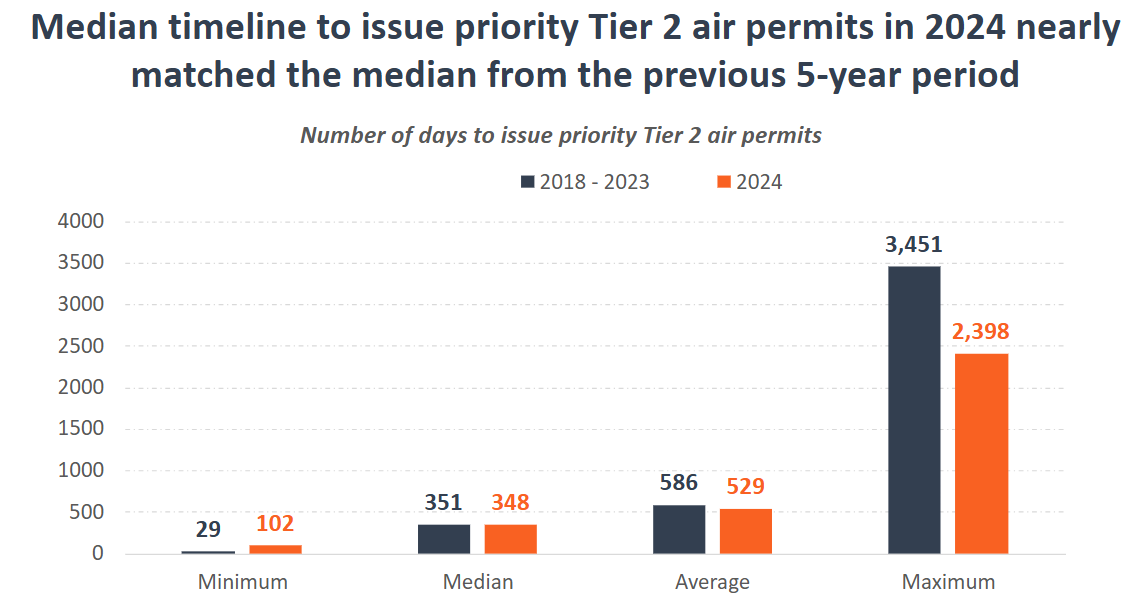
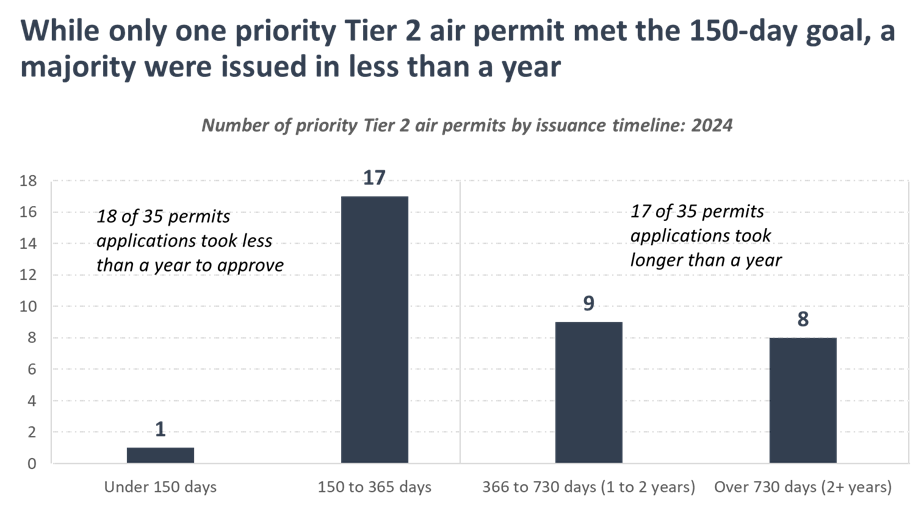
Recommendation: State regulators should address backlogs of permit renewals and minor facility changes for air and water permits.
2024 progress
Backlogs of permit reissuances and modifications improved modestly in 2024. However, non-priority Tier 2 air and water permits continue to face years-long review times, and a high number of permits are awaiting assignment or past their permit term.
Background
Previous research from the Minnesota Chamber Foundation found a significant backlog of air and water permits that had been in process for years or were still waiting to be assigned to agency staff. Much of this backlog related to permit reissuances or changes to existing permits. This backlog results in long timelines to issue or reissue non-priority Tier 2 permits. For example, findings showed that non-priority Tier 2 air permits took an average of 1,295 days to be issued, with Title V permit renewals averaging nearly 1,500 days.
Additionally, as of November 6, 2023: MPCA had approximately 371 air permit applications awaiting assignment; approximately 25% (91 of 371) had been awaiting assignment for less than 365 days; the remainder (280 of 371) had been awaiting assignment for anywhere from 1-30 years.
Individual industrial water permits (NPDES/SDS permits) faced deep backlogs as well. Of the 226 NPDES/SDS permits currently administered by the MPCA, 152 were administratively continued (i.e. past the expiration date, but still in effect) as of the end of Q3 2023. The average amount of time these permits are administratively continued was 6.5 years, with the longest being 23 years.
Addressing these backlogs could allow hundreds of facilities in Minnesota to operate with an up-to-date air or water permit, providing greater assurance to businesses and communities. Further, improving the process by which permit applications are assigned to staff writers could improve efficiency without reducing any thoroughness of the review.
Assessment of 2024 outcomes
Non-priority Tier 2 air permits:
The MPCA issued 55 non-priority Tier 2 air permits from November 2023-December 2024. These permits were issued in a median of 786 days, down from a median of 887 days in the previous five-year period. The majority (38 of 55) of these permits were federal individual reissuances, which often face the longest timelines since the business can continue operating under their existing permit while they await its reissuance. This pattern continued in 2024, with federal reissuances experiencing the longest timelines of all permit types at an average of 1,892 days. The remaining 17 non-priority permits – which include permit amendments and state individual permits – ranged from an average of 232 days (moderate amendments) to 797 days (major amendments).
Air permits in process or awaiting assignment:
As of February 2025, 441 air permit applications were either still awaiting assignment or were in process. These permits had been in the queue or in process for a median of 1,270 days since their submission. The majority (79%) consisted of administrative amendments, federal individual reissuances and minor amendments.
Consistent with past research, this review found that a significant number of permits remained unassigned to MPCA staff. According to data from the MPCA Air Permits Received dashboard, 326 of the 441 applications (74%) were still awaiting assignment as of February 2025, down from 371 applications that were awaiting assignment at the end of 2023. While the number of permits awaiting assignment has declined, the length of time before assigning permits to agency staff remains a concern. Eighty-eight percent (88%) of these applications have been awaiting assignment for longer than six months, and over half (54%) have been awaiting assignment for longer than three years. It is not clear how many of these permit applications are still needed or to what extent their years-long time in the queue poses a challenge to permit applicants. Further research should examine this question and identify solutions for creating a timely process of assigning a permit application to agency staff for review.
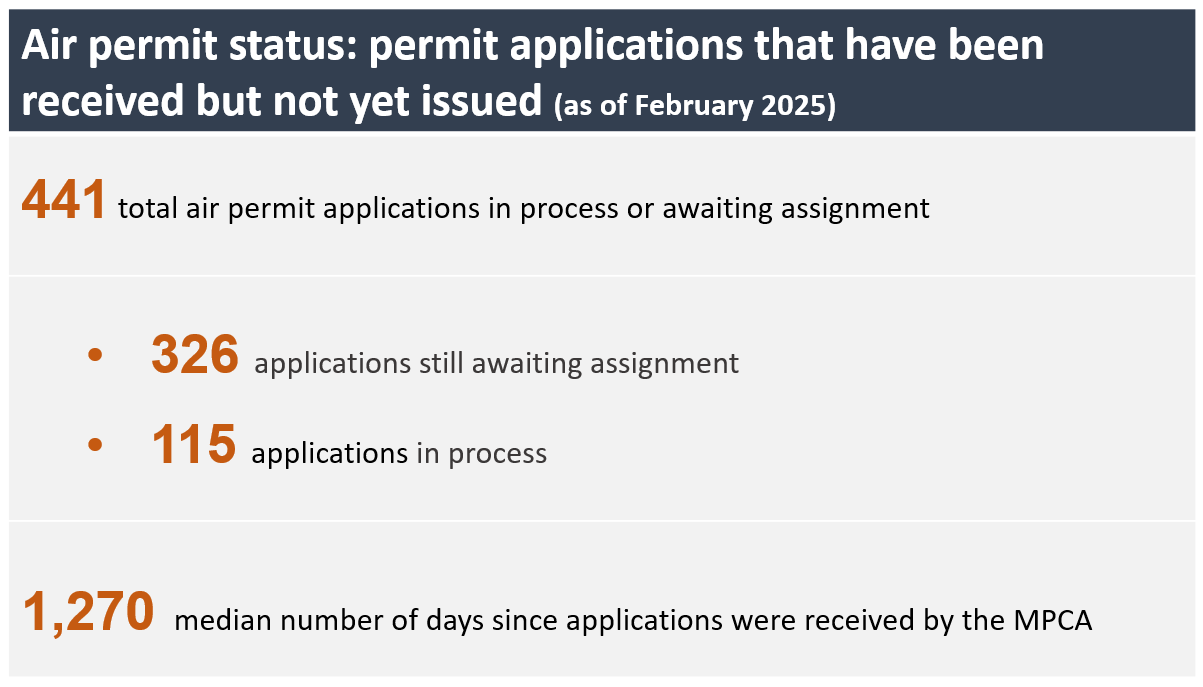
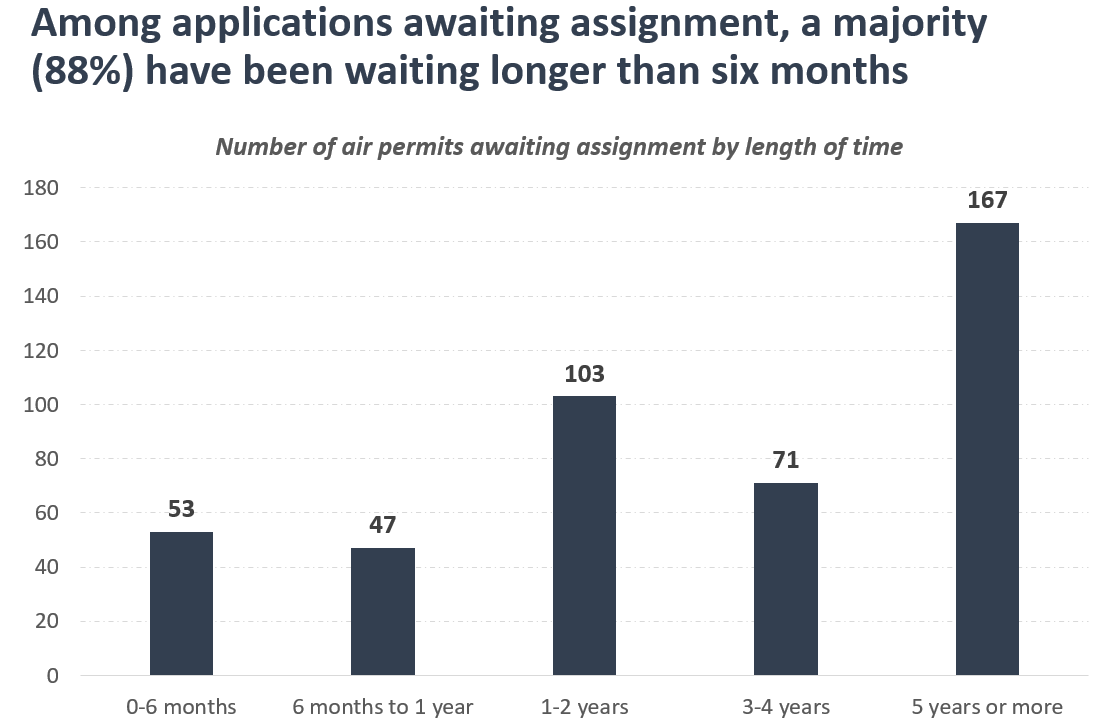
Individual industrial NPDES water permits:
Backlogs of individual industrial NPDES permits improved modestly in 2024, compared to the previous year. The number of businesses operating with an up-to-date individual industrial permit (i.e. within their permit term) increased from 74 to 82. Similarly, the number of administratively continued permits (i.e. extended beyond the permit term) decreased slightly from 152 to 148. As of the end of Q4 2024, 64% of all individual industrial NPDES water permits in Minnesota were administratively continued, down from 67% in 2023.
Despite this improvement, the share of administratively continued permits remains well-above typical levels in other states and should be further addressed. Additionally, among those permits that are administratively continued, the average number of years that those permits were past the expiration date increased to 7.2 years.
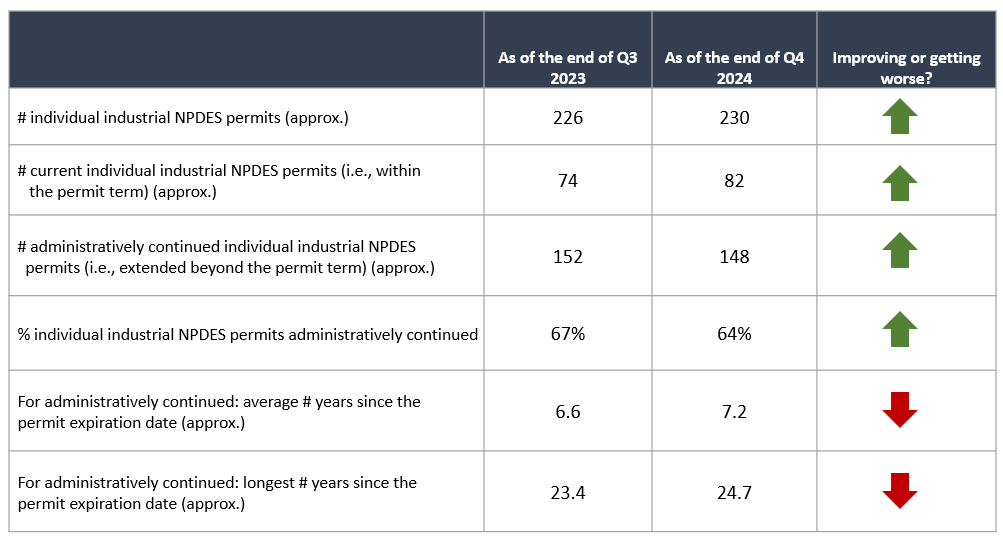
Recommendation: Minnesota should improve transparency, certainty and collaboration throughout Minnesota’s permitting and environmental review programs.
2024 progress
Actions taken over the last year create a mix of both promising improvements and further burdens to Minnesota’s environmental permitting and review programs.
Background
The Minnesota Chamber Foundation’s 2024 report on environmental permitting identified numerous opportunities to improve overall transparency and certainty in the state’s air, water, wetlands and environmental review programs. Some of these programs, such as environmental review, lack reliable and accessible data to track project timelines and identify opportunities to improve processes. Other programs, like air and water permitting, had mixed results in providing permit applicants with expected timelines and milestones throughout the process. Minnesota’s environmental permitting process can be complex, requiring adequate collaboration and support for applicants. The report argued that implementing reforms could improve businesses’ ability to predict and plan capital investment projects, as well as better understand their regulatory compliance obligations.
Assessment of 2024 outcomes
Several steps were taken in 2024 that may increase support and transparency for permit applicants or project proposers. Some actions taken over the past year included:
- State policymakers passed legislation in 2024 requiring state agencies to provide coordinated project plans upon request. This policy is intended to create greater transparency for project proposers, allowing them to better plan and predict steps in the review process. A coordinated project plan defines agency roles, public meeting schedules, and deadlines for environmental reviews and permits, ensuring compliance with state requirements. (Minn. Session Law – 2024, Regular Session).
- A Minnesota Business First Stop report, Moving Minnesota Forward, highlights efforts to improve processes and interagency alignment for complex development projects. The report notes, for example, that the Minnesota Pollution Control Agency (MPCA) has adopted a “centralized project management process for complicated and higher public profile projects.” This approach aims to enhance communication among stakeholders involved in proposed projects. According to the report, the MPCA will “evaluate success by the number of proposed projects completed on time based on the coordinated project plan and continuous feedback from project proposers and stakeholders.”
- Governor Walz included several proposals to support permitting efficiency in his 2026-27 budget proposal, including funding for a permitting ombudsman, additional staff to address permit application backlogs and a “credentialing” system for consultants.
- The MPCA is rolling out a new online permit application tracker that shows where permit applications are in the review process. The online tool covers permitting activity across various air, water and land permit programs.
- The Environmental Quality Board (EQB) introduced a new process to begin surveying Responsible Government Units (RGUs) to gather more information on environmental review projects. These surveys may reveal opportunities or additional challenges to improving environmental review processes, including potential bottlenecks that could be addressed at the local level.
However, other changes last year posed additional challenges for permit holders and applicants. For example:
- The MPCA introduced new requirements for permit applicants to use agency-provided emissions calculator spreadsheets. Feedback from businesses and consultants indicates that this new process will create additional challenges for applicants. For example, the MPCA will have to update spreadsheets any time underlying assumptions change, and the new forms will require permittees to spend significant time revising internal workbooks that have been developed and refined over time. Such barriers could further complicate and slow down the permit application process.
- New proposals to create a “ticketing authority” for the MPCA to assess punitive fees for missed deadlines on permit applications and renewals would impede collaboration between the agency, permit applicants and third-party consultants, potentially making engineers less willing to work on such projects.
- The MPCA introduced a new air modeling policy that requires facilities undergoing a moderate or major permit amendment project with emissions increases over certain thresholds to provide assurance that the project or facility is unlikely to cause or contribute to a NAAQS/MAAQS exceedance. There are numerous triggers for air dispersion modeling already, and this new policy will introduce one more. While the agency has proposed language to codify these requirements into law, the approach raises questions about the authority under which these changes were implemented.
Back to top
Actionable strategies
The Minnesota Chamber Foundation’s 2024 report identified 18 key recommendations to streamline the state’s environmental permitting system. While some progress has been made over the past year, we encourage policymakers and regulators to explore these ideas for further improvements.
See full recommendations in the original report here: https://www.mnchamber.com/minnesota-chamber-foundation/streamlining-minnesotas-environmental-permitting-process-actionable
Air permitting
- Review and revise approach to completeness evaluations.
- Provide additional support for permit applicants.
- Use a separate construction and operating permit program.
- Review and revise expedited permitting options.
- Encourage applicants to use Tier 1 permitting options when possible or consider expanding the existing registration and capped permitting programs.
- Continue to expand online air permitting services, while soliciting and acting upon user feedback to improve user experience and reliability.
- Review and potentially address the permitting queue of “old” air permit applications (applications that have not been assigned but were received more than 365 days ago).
- Make air permitting data more accessible to permittees and the public.
Water permitting
- Further prioritize commitment to permit issuance timelines.
- Find opportunities for the MPCA to improve process efficiency.
- Develop an online resource for water permitting data.
- Reduce regulatory complexity.
Wetlands
- Complete the 404 assumption process.
- Expand the BWSR annual LGU report to include timing on completeness review and decisions.
- Revise Minnesota Statute 15.99 Subdivision 3(f) to be clear about the maximum number of times a RGU can extend the initial 60-day decision timeframe for WCA determinations.
Environmental Review
- Improve transparency of Environmental Review timelines and outcomes.
- Narrow the focus on the required EAW content.
- Align the mandatory EIS Process with NEPA.
Back to top
About the Minnesota Chamber Foundation
The Minnesota Chamber Foundation is the state’s leading private-sector resource on the performance of Minnesota’s economy. Its first economic research— Minnesota: 2030 was released in 2021 as the state was emerging from the pandemic. This flagship report details the state’s economic assets and challenges, and provides dozens of recommendations and strategies to accelerate Minnesota’s growth leading to 2030.
Additional reports from the Foundation detail the benefits of immigrants to the state’s economy; the state of entrepreneurship and consistent updates to our original Minnesota: 2030 report. Looking ahead, the Foundation will produce a piece on migration trends in Minnesota. Domestic migration and immigration are critical factors that impact the growth of the economy, but are often misrepresented or misunderstood.
The Foundation’s work has become a trusted resource for the media, policymakers and business leaders. The data and research help inform business decisions and policy solutions.
The Foundation is also home to a nation-leading workforce inclusion initiative. Designed to be a practical approach to accommodate all dimensions of diversity across Minnesota, our efforts have gained tremendous momentum with small and mid-size businesses and those located in Greater Minnesota. These companies comprise the majority of Minnesota workers, and business leaders understand both the economic and moral imperative to creating inclusive work environments.
In addition, our partnership with local chambers of commerce through our Business Education Network continues to grow, connecting students to high demand careers in their communities.
To learn more about the Foundation’s work, please contact the staff listed on the back of this report.
We welcome your engagement and your investment in our efforts.


